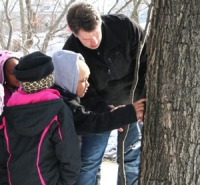We love questions like this! And now we finally have a robust platform with data sets rigorous enough to begin (and it is just a beginning) to answer some of these questions. It is so darn exciting to be able to provide a taste of some of our early findings about park use.
Thanks to several research partnerships, the Urban Ecology Center is now collecting data to help us understand the impact of our work to make parks safe, accessible and ecologically vibrant for people living near the parks.
Under the guidance of our Community Science research team, John Schneider, a student in the UWM Geography Department, developed protocols to measure how natural areas adjacent to each of our Centers are used by the general public. This was no easy task. We can’t be in the park 24/7 counting and interviewing people, so population estimation based on our sample was required. Plus, we didn’t want to double count park use by people participating in all Center-run activities, who are already part of our evaluation. Our data collection needed to be comprehensive, but simple enough for students and volunteers to carry out the research year round, long after John’s project was over. And it needed to meet the Center’s goals and John’s academic requirements.
Luckily, John was able to vet research methods over the summer with our research advisors and his academic team, so that (after several iterations) the study was launched during the fall semester, corresponding to the start of the Center’s fiscal year. After a successful hand-off, two students from Cardinal Stritch are continuing the project this semester. Our estimates will improve as we collect more data over all seasons and over multiple years.
Here is some of what we’ve learned:
Most exciting is that we now have an estimated number of people visiting parks and trails during the first 6 months of our fiscal year: just under 45,000 people in Riverside Park, just over 40,000 people in Washington Park and about 23,000 in the Menomonee Valley. There is more recreational use of Washington Park by children and youth than adults. In Riverside Park and Menomonee Valley the vast majority of park users are adults.
Most common activities, in order of frequency, include biking, walking, playing, jogging and dog walking. Other uses include sitting and fishing. Surveys were conducted 7 days per week and during morning, afternoon and evening periods.
A large part of the Center’s mission is to encourage people to get out into nature. While we love it when people do this through our programs, we get really excited when people are inspired to explore on their own. This is at the heart of all we do and is the reason we work so hard to make sure our parks are inviting and safe. Combining the Park Use estimates and the Center’s 45,600 program participants, over 150,000 people were impacted by our work in the first 6-months of our fiscal year. Wow!
In addition to learning about how people are playing in nature, through a second study we are deepening our understanding of the impact of outdoor play on health and well-being of children. This robust research partnership includes six schools (Academia de Lenguaje y Bellas Artes School, Alexander Mitchell Integrated Arts School, Greenfield Bilingual School, Longfellow Elementary School, Nativity Jesuit Middle School and St. Rafael the Archangel School), the Medical College of Wisconsin, Menomonee Valley Partners, and UWM’s Center for Urban Initiatives and Research. This project specifically focuses on the Menomonee Valley neighborhood, where in July we will significantly increase access to nature with the grand opening of the new park.
5th and 6th grade students shared the following information with us:
- 86% said that being in nature helps them think more clearly
- 94% say they feel healthier
- 75% indicated that nature helps them calm down when they are angry
- 85% of the students also indicated that they think being outside in nature is fun!
- While these students think that being in nature is fun and healthy, 85% of students also indicated that their parents do not encourage outdoor play and 35% of these same students spend more than 3 hours in front of the TV and an additional 42% spent 1-3 hours watching TV each day.
Which makes us ask: if playing outdoors in nature doesn’t cost any money, is considered to be fun and healthy by kids (and many studies), why don’t parents encourage their children to play outside in nature as often as possible? As an organization that strives to continually learn and to deepen our impact, the Urban Ecology Center’s aim is to dig into this question next.
There is so much more to learn, but it appears from these two studies that nature can provide thousands, even hundreds of thousands, of urban residents an opportunity to learn, relax and engage in a healthy lifestyle outside in nature near their home.
Although this project called the “Urban Ecology Center” is far from over (and hopefully never will be) we now have one more source that shows us that it works!





